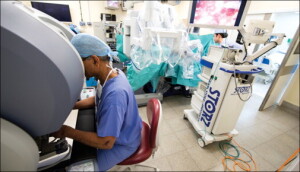For prostate cancer, study finds robotic surgery outcomes same as non-robotic
by
Christina Hwang, Contributing Reporter | August 01, 2016

Longer-term follow-up is needed
to fully assess outcomes
Dr P Marazzi/Science Photo Library
The first trial of robotic versus non-robotic surgery for prostatectomies, the removal of the prostate gland, found that both types of surgery have similar outcomes in terms of quality of life, according to a study published in The Lancet.
For the study, 157 men with prostate cancer received robot-assisted surgery and 151 received open (non-robotic) surgery, and all were followed for 12 weeks after their operation.
Robot-assisted laparoscopic prostatectomy (RALP), which uses a high magnification 3-D camera, allows the surgeon to examine a patient’s abdomen through an incision. The camera is attached to one of four arms while the other three hold the instruments needed for the surgery.
Results from the study showed that there were no differences in quality of life, such as urinary or sexual function for both groups, and that there were also no differences in the number of post-operative complications.
Right after surgery, the patients who underwent robotic surgery said they experienced less pain performing everyday activities and reported better physical quality of life at six weeks. After 12 weeks the differences in both groups were not significant, and leveled out.
The researchers said that urinary and sexual function could improve for up to three years after surgery, so the differences in the two groups could become apparent later on.
“Patients are now being followed-up for a total of two years in order to fully assess the longer-term outcomes, including cancer survival,” said lead author Professor Robert Gardiner, from the University of Queensland Centre for Clinical Research, in a statement.
The most common treatment for localized prostate cancer is surgery, and in the U.S., 80 to 85 percent of these surgeries are done robotically. It is most commonly used for prostatectomies, but it is being used more in gynecology, cardiothoracics, head and neck, and general surgery.
|
|
|
You Must Be Logged In To Post A Comment
|
